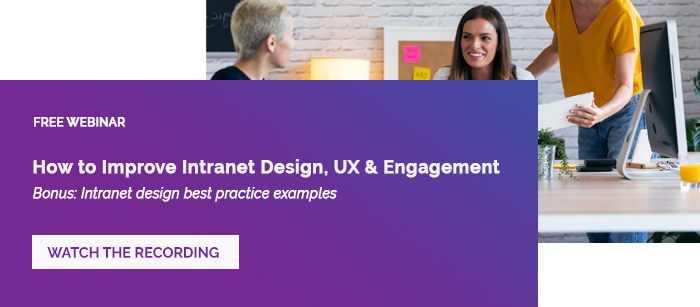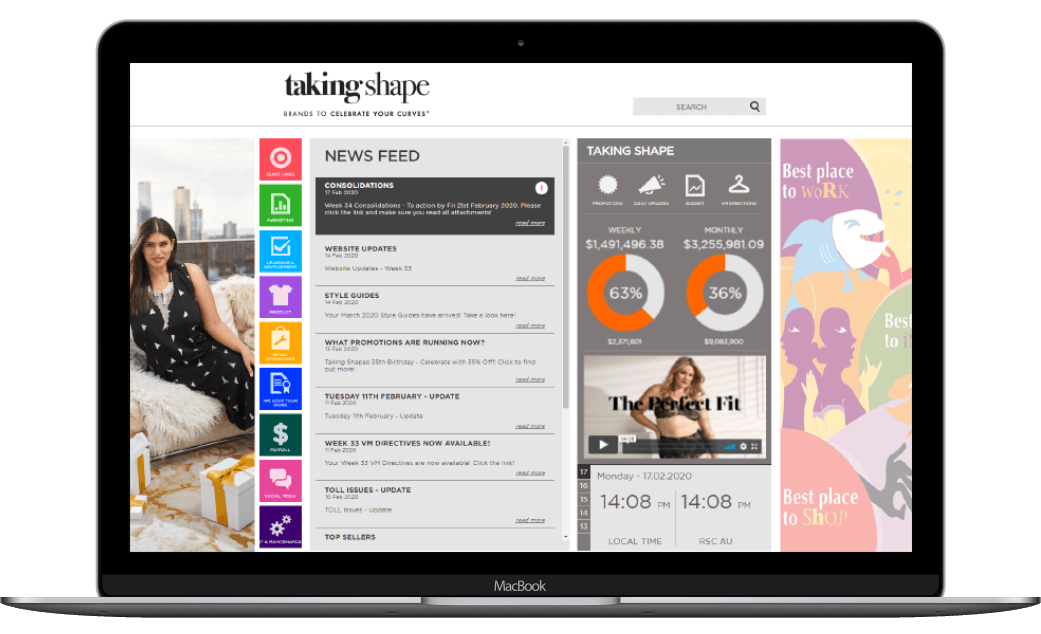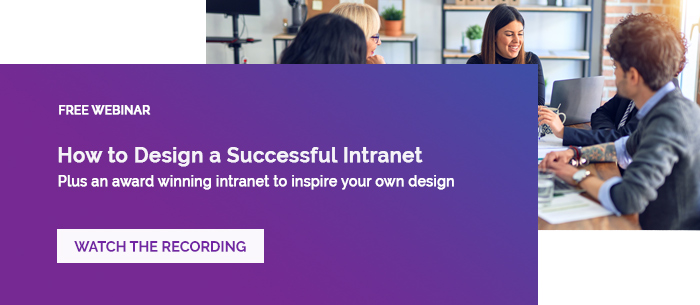An intranet, on a fundamental level, brings your organisation together. It’s accessible anywhere in the world by any member of your organisation (with access levels of course).
At least it should be. And it can be.
With the right design.
Today, we'll explore the intranet design process, from sign-off to soliciting feedback and suggestions.
Intranet Design Guidelines
Great intranet design can increase your company’s productivity when it is implemented with the right mindset, strategy, and information in place.
It can be tempting to delve straight into the design and wireframe part of an intranet project after sign-off.
But great intranet design goes beyond the look and feel.
Here are the key intranet design best practices that can help you build a valuable intranet that will support your employees, no matter where they're working from:
- Make it Fit for Purpose
- Plan Ahead
- Choose the Right Functionality
- Be Selective
- Utilise the Right Resources
- Get the Word Out
- Focus on Feedback and Enhancements
For more insights, check out this blog post on 'Intranet Best Practices: Everything You Need to Know' or check out the webinar 'How to Improve Intranet Design, UX and Engagement'

1. Make it Fit for Purpose
What is the purpose of your intranet?
It’s an essential support tool that provides employees with access to information and tools that help them do their jobs - and enjoy doing their jobs. It makes it easy to find accurate and up-to-date information. It streamlines manual and convoluted business processes. It connects them to the right people and resources. It aligns them with corporate goals and the organisation’s vision.
With this in mind:
- Start with your employees who will use your intranet and find out what do they need from the intranet.
- Then tie this in with your business requirements. What are the intranet goals? How does the intranet help the business achieve its organisation and strategic goals?
- And finally look at content that already exists. Perform an inventory of content – where it resides, who owns it and whether it can or should be managed on the new intranet.
Now that you have the pieces of the puzzle, you can start to group them together to form your intranet architecture.
Card sorting is helpful for involving end users in this process. You then use the results to draft your architecture and ask end users to check that you have the right hierarchy and terminology.
Using this information to create an information architecture that makes it easy for employees to perform the task needed - is more important than the flashiness of the design!
Remember, it’s about usability and providing the end user with what they need.
For more insights, check out this blog post on '5 Key Factors to Optimising Your Intranet Usability and User Experience'.
2. Plan Ahead

Formalise all this information into a plan to guide you through the intranet design process.
There are many aspects you need to plan for with your intranet project, and some questions to ask yourself:
- Put together an intranet strategy
What are your intranet goals and how does it help you achieve organisational goals? How will you collect feedback from end users to decide what is needed?
- Corporate visual identity:
Your branding and the tone of voice involved in your intranet must reflect your company culture, goals and objectives
- Must have vs nice to have intranet features
What intranet features will be needed for the phase one launch? What features will be needed for the next phases?
- App integrations:
Which tools will you integrate to your intranet (if any)?
- Intranet committee:
Who will help you decide which vendor to choose? Who will help you test the design before it goes live? Who will provide ongoing feedback during the project? Who be your intranet champions internally to build up hype?
- Hosting solutions and service agreements
Choosing the right hosting provider is imperative for ensuring your intranet can be accessed 24/7. Choose a service that is secure and can carry sufficient load for your intranet.
- Costing:
Aside from domain and hosting subscriptions, check the ongoing maintenance cost of your intranet.
- Security:
What security protocols and tools are in place to ensure the intranet remains safe and secure? Consider how this may affect the design of the intranet.
For more insights, check out our guide on 'How to Successfully Plan, Deploy and Launch an Intranet'.
3. Choose the Right Functionality
The right design is one that is easy for employees and other stakeholders to navigate and access data.
When it comes to information architecture, content needs to be nested in the right categories and positioned so it doesn’t appear overwhelming to end users, while making it easy for them to quickly find what they need.
And of course, a good intranet design is customisable. It is standard practice to choose an intranet with out-of-the-box features to allow for quick deployments. However, it’s important to note that every organisation is unique and therefore the needs of employees will differ. To ensure the intranet is as valuable as possible, the enterprise intranet software should allow you to customise the design, from the complete look and feel, to information that is surfaced and displayed from third party systems.
For example, Taking Shape is Australia and New Zealand's leader in plus-size clothing, with over 100 standalone Boutique stores, 50+ Concession stores within the department store, Myer, and a global online store. They designed their intranet homepage to graphically present sales targets and results unique to each store with an aggregate view for their Retail Support Centre (RSC). These figures are updated automatically 3 times a day and makes it easy for any employee of that store to understand what the sales targets and figures are.

Another important aspect to consider is to know what type of content is accessible to a specific group of people and restricted for others.
For more insights, check out this blog post on 'How to Choose and Evaluate the Best Intranet Software'.
4. Be Selective
You don't have to add everything and the kitchen sink into your new intranet design. Only add in what your users need!
Some things to keep in mind:
- Be selective with your content. Conduct a content audit to see what already exist that should be moved over to the new intranet. Then get departments to add in new content. This will prevent your intranet design from looking bare from the lack of content, while also stop it from becoming another dumping ground of content right off the bat. Remember intranet’s allow you to use taxonomy to tag content so the same content can appear in multiple locations. This avoids duplicate content being added multiple times and cluttering the intranet.
- Not all content will be relevant to everyone. Personalise what users see on their intranet interface. Information like relevant news within the organisation, calendar of events, updates to team workspaces, policies and procedures, forms that need to be filled and much more – can be personalised and available on a central interface – making it easier for employees to perform their roles and be across what’s happening within the organisation.
- Make sure your intranet plays nicely with third party systems. For example, if you already have a document management system such as SharePoint, simply integrate with it, rather than add the same document on your intranet. This avoids having duplicate content across multiple systems. As a bonus, intranet's allow you to open and edit SharePoint documents from the intranet's interface so the user doesn't need to leave the site.
For more insights, check out this blog post on '7 Things Your Intranet Needs to Be Successful'.
5. Utilise the Right Resources

By examining successful intranet examples, it becomes clear that the best intranets are only ever developed when their implementation is supported by a team of highly skilled experts.
Do you have in-house resources to assist? From web designers, to colleagues who can assist with populating content on the new intranet, and others who can provide feedback on the user experience and layout. If so, ensure you have the right people in-house on board for different steps of the intranet journey.
Or will you need end to end support from the intranet software providers, vendor or agency? These are experts to help with the new design and can assist with information architecture, audience-journey mapping, prototyping, user research, wireframes, mockups and the visual design.
The benefit of an external project team is they can both fill in internal team gaps, as well as provide a new or fresh perspective as these teams are across industry best practices, having worked on several intranet projects.
For more insights, check out this blog post on '6 Things You Should Be Looking for in an Intranet Provider'.
6. Get the Word Out
Communication is the key to driving the success of your intranet. Employees and stakeholders should know about the upcoming launch of the intranet to improve adoption rates but also creates an expectation of improved processes and workflows.
Some intranet launch ideas:
- Launch video
- Interactive tour
- Training lunch and learn sessions
- Physical launch initiatives such as post cards and promotions on the office TV
- Scavenger hunt
- Photo competitions
For more insights, check out this blog posts on 'Proven Launch Ideas to Increase Engagement' and '4 Phases of a Successful Intranet Adoption Strategy'.
7. Focus on Feedback and Enhancements
The launch itself is not the end of it, but the beginning of the process of improving it further.
Assessing the effectiveness of the intranet after the launch is the very first step to understanding how valuable it really is.
Aim to implement an easy way for employees to ask questions and provide feedback such as a 'Feedback' button on side of the intranet interface that is visible on all pages.
Where possible, it is considered best practice to launch your intranet in phases.
The first phase should include the must have and quick to deploy components of your new intranet. This will allow you to go live with the new intranet sooner, as well as gather feedback to ensure the next iteration of your intranet - particularly the design, usability and content - is more valuable than the previous iteration. This can be a small design tweak or a large change to a section of the intranet such as a change to the global navigation menu.
For more insights, check out this blog posts on '8 Smart Ways to Measure Your Intranet Success'.
What Next?
Intranet design is fundamental to the success of an intranet. But the same easily-made mistakes often end with an inadequate, expensive and cumbersome platform with low adoption rates.
Get the design and build right for your intranet, the first time around. Watch the on-demand webinar and discover what it takes to design a successful intranet.
